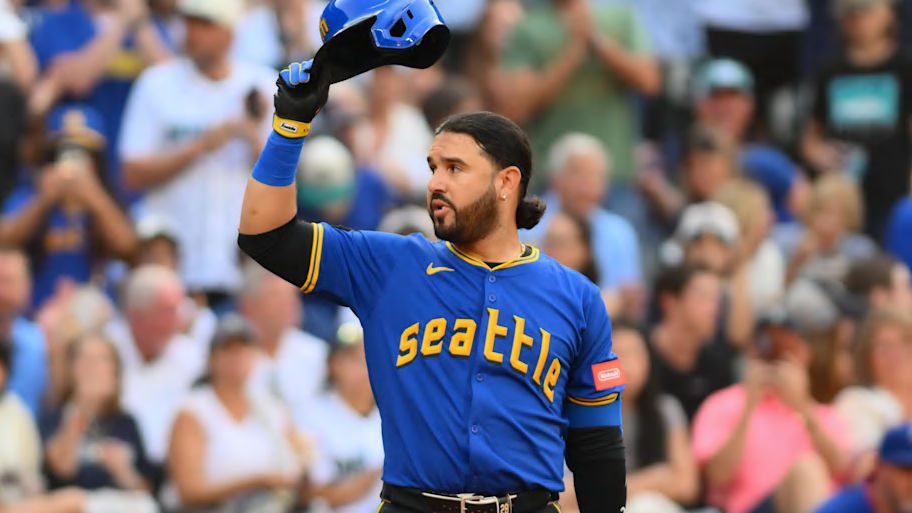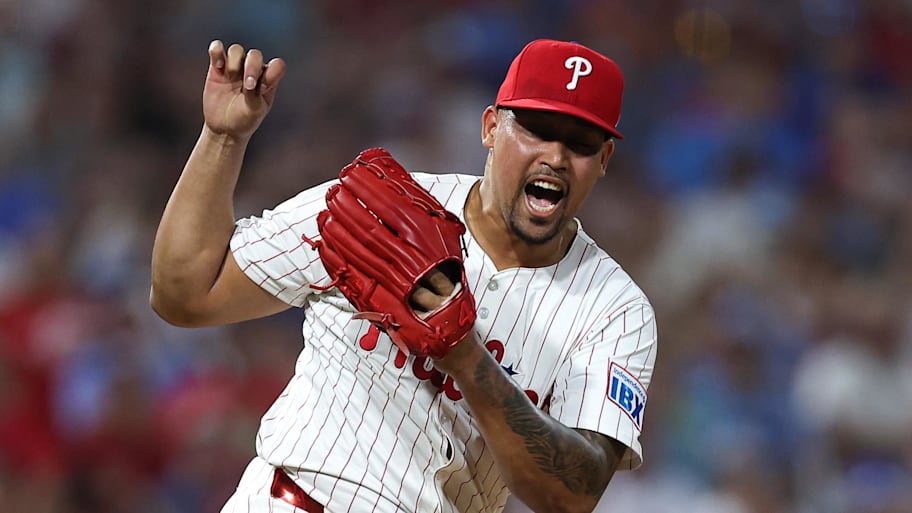MLB has turned the page on a memorable trade deadline that ramped up exponentially in activity over its final 24 hours. It featured extreme buying, such as the Padres’ dizzying, prospect-exporting pursuit of championship upgrades, and selling, thanks to the Twins’ stunning teardown. And somewhere in between, multiple clubs managed to make needle-moving trades as they geared up for the stretch run in the dog days of summer.
Which club made the most impactful splash among the pool of contenders? Did Padres president of baseball operations—and mad scientist—A.J. Preller provide the team with enough tools to overtake the defending-champion Dodgers in the National League West? And could postseason hero Carlos Correa be the x-factor that lifts the Astros to another World Series this fall? We’ll answer these questions and more in another edition of Fact or Fiction.
Jhoan Durán trade was the biggest deadline needle mover
Verdict: Fact
There were plenty of major upgrades at the trade deadline. Eugenio Suárez’s reunion with the Mariners gives the club some much-needed third base production and some added protection behind American League MVP candidate Cal Raleigh. Correa’s return to Houston, while eliciting waves of nostalgia for the team’s fanbase, also makes a ton of sense for the Astros in the wake of Isaac Paredes’s potentially season-ending hamstring injury. The Blue Jays acquired a potential October ace when they dealt for 2020 Cy Young Award winner Shane Bieber. But the most impactful upgrade? That was Philadelphia’s blockbuster deal for flamethrowing closer Durán.
Durán is electric. The man ranks in the 100th percentile in average fastball velocity and once tested the limits of radar guns with a 104.8 mph heater back in 2023. Heck, he’s already set the Phillies franchise record for the fastest pitch in the pitch tracking era. And all that heat, coupled with a wicked, upper-90s splinker, has been hard for hitters to square up. Durán owns a sparkling 31% whiff rate, and when hitters aren’t swinging and missing, they’re usually depositing the ball directly into the dirt for harmless ground balls.
Add it up, and it’s the perfect recipe for a stress-free ninth inning, which is music to the Phillies’ ears. Manager Rob Thomson has tried three different relievers in the ninth—Jordan Romano, Orion Kerkering and Matt Strahm—and none have had the juice necessary to be a playoff closer, combining to blow 11 saves. But Durán? His 1.93 ERA, 18 saves and just two blown saves in 2025 need no introduction.
Durán does have an electric introduction, though, and it’s already made its way to Citizens Bank Park. If the October-bound Phillies can get the ball to Durán with a lead in the ninth at their home field—where they have the best playoff winning percentage in baseball history—it would be hard to bet against them. For a Phillies club wounded by blown leads from October’s past, Durán might just be the glorious salve.
The Twins gave up on their core too soon
Verdict: Fiction
For a Twins fan base that hasn’t tasted a World Series win in 34 years and hasn’t witnessed the club advance past the division series in 23 years, the trade deadline had to be jarring. Like a soon-to-be-bankrupt store with half-off everything signs plastered out front, the Twins weren’t just open for business, they were welcoming it with outstretched arms. No fewer than 11 players headed out the door via trades. After the dust settled, Minnesota’s lineup looked far different, and its bullpen was almost completely unrecognizable.
For the fans who were hoping the Twins might cautiously buy, or, in the imagined worst case scenario, straddle the line between buying and selling, there’s little to be said in the way of moral support. The unfortunate reality is this shocking fire sale was a reminder that baseball—and professional sports at large—is a business. The Pohlad family, which has owned the Twins since 1984, announced last October it would “explore a sale” of the franchise. Did such a monumental decision factor into the payroll-slashing trade frenzy that ensued last week? There’s no way to definitively say, but it’d be naive to think it wasn’t at least part of the conversation.
However, maybe, just maybe, this was the perfect storm for the Twins. Consider the club’s recent history. After missing the playoffs for six straight seasons from 2011 to ‘16, Minnesota made the postseason three times in the first four years of Derek Falvey’s tenure as the head of the front office. After winning the AL Central in ‘23, the Twins’ owners slashed payroll from $160 million to $130 million, a puzzling decision that led to predictable results.
Minnesota stumbled to an 82–80 record and missed the postseason last year, then added just three free agents as they continued to operate under a tighter budget. Is it any wonder, then, that the team was six games under .500 heading into this year’s deadline?
At some point, the Twins had to be awoken from this stupor of mediocrity. And while almost nobody wanted the awakening to emerge from a potential sale of the team—which comes with plenty of question marks—perhaps it will end up being a blessing in disguise. The Twins already had MLB Pipeline’s 10th-ranked farm system heading into 2025. After the trade deadline, the Twins’ farm now boasts six top-100 prospects, and some semblance of hope for the future in the face of uncertainty. The fire sale was devastating. But like a phoenix, maybe the new-age Twins will emerge from the ashes.
The Mariners are serious threats to make the World Series

Verdict: Fact
Of the trade deadline winners, the Mariners might just have been the biggest. Within striking distance of the AL West-leading Astros, Mariners president of baseball operations Jerry Dipoto eschewed the cautious approaches of deadlines past and swung for the fences, acquiring the two best bats available—Suarez and first baseman Josh Naylor—without surrendering a top-10 prospect.
But he didn’t stop there. Dipoto added lefty reliever Caleb Ferguson, who excels at limiting hard contact, to a bullpen that had just one southpaw (Gabe Speier) in it. The Mariners lineup, already relatively balanced around AL MVP candidate Cal Raleigh, now looks like a murderer’s row with Julio Rodríguez and Randy Arozarena finding their strides. Seattle’s rotation, which suffered injuries to George Kirby, Logan Gilbert and Bryce Miller earlier this season, is nearly whole. And the bullpen, headlined by All-Star closer Andrés Muñoz, ranks eighth in MLB in ERA.
Seattle has made the postseason just once since 2001 and has never appeared in the World Series. In a year where seemingly every contender is somewhat flawed, the Mariners have as good a chance as any team to capture a championship. To borrow from a certain quarterback who won a Super Bowl in Seattle, the Mariners need to ask themselves the question, “Why not us?”
The Padres could overtake the Dodgers in the NL West
Verdict: Fact
In the class of buyers, no one was busier at the trade deadline than San Diego. The Padres shipped out eight of their top-30 prospects en route to adding high-octane relief pitcher Mason Miller, productive bats Ryan O’Hearn and Ramón Laureano, and catcher Freddy Fermin.
As they say, scared money don’t make money, and the fearless Preller made a flurry of trades with one clear objective in mind. “If you’re going to win a championship, you can’t have any weak links,” Preller told reporters after the deadline. And it’s clear that the Padres have fewer of those now than they did before July 31.
Left field had been a revolving door of lackluster productivity at the plate for San Diego this season. Enter Laureano and his .887 OPS. The Padres ranked second-to-last in baseball in designated hitter WAR. Enter O’Hearn, a 2025 All-Star who has racked up 2.6 WAR and an .822 OPS in 98 games this season. The Padres also upgraded at the catcher position with the addition of Fermin, a solid pitch framer with a capable throwing arm.
Preller may have gotten greedy by paying a steep price to add Miller to what was already the league’s best bullpen, but that only further reinforces this next point. San Diego, currently holding the third wild-card spot and just three games back of the first-place Dodgers, is now a legitimate World Series contender. And one possible path there—winning the division—was once out of the question but is now a real possibility.
Just a month ago, the Padres were eight games back of the Dodgers and perhaps mentally preparing to play a wild-card series come October. Since that point, Los Angeles’s bats, especially former AL MVP Mookie Betts, have gone cold while its bullpen has been riddled by injuries. But these are still the defending champions with a starting pitching staff that’s nearly at full strength again. The Dodgers won’t go down quietly in the fight for the division.
The Padres, who have lost five of seven games against the Dodgers so far this year, will play two more regular season series against their bitter rivals, with all six games coming this month. Whoever fares better in those matchups could have the upper hand in the race for the division crown. And, after a busy deadline, these Padres pack more of a punch now.
Carlos Correa can still be a difference maker for the Astros
Verdict: Fact
The Astros’ stunning acquisition of Correa was a reunion between two parties who once made great music together, a beautiful mix of idealism and realism. Houston is where it all began for Correa, the first overall pick in the 2012 MLB draft. And Houston is where Correa helped bring glory to a franchise that missed the playoffs every year from ‘06 to ‘14.
Correa was a part of five consecutive American League Championship Series appearances, three World Series berths and one championship. He not only became one of the faces of a dynastic-like era of Astros baseball, but he also time and time again played the hero for Houston in the postseason. So, for Astros fans, seeing Correa back in Houston threads brings back warm and fuzzy feelings. But why couldn’t it do more than just provide a healthy dose of nostalgia?
Correa, 30, has scuffled to a .704 OPS in 97 games and has rated as a slightly below average as a fielder at shortstop. After the trade to Houston, Correa spoke about how he’s been pondering a move from shortstop, where he once won a Platinum Glove, to third base, where he had only played during the World Baseball Classic. As he enters his thirties, the less physically taxing hot corner is looking more and more appealing to Correa, who has dealt with his fair share of injuries.
So here’s where realism comes into play. The Astros lost starting third baseman Isaac Paredes to a hamstring injury, and while the 26-year-old is foregoing surgery, there’s no telling if he’ll be able to return later this season—or how effective he’ll be. There’s reason to believe Correa, equipped with a sturdy 6' 3" frame and strong arm, can handle third base. Plus, Houston may get more out of his bat going forward, given he was elite at the plate as recently as last year. And the October-bound Astros know this better than anyone: put Correa on the postseason stage and he’s bound to shine.
More MLB on Sports Illustrated
This article was originally published on www.si.com as MLB Fact or Fiction: Predicting the Effects of the Trade Deadline.
